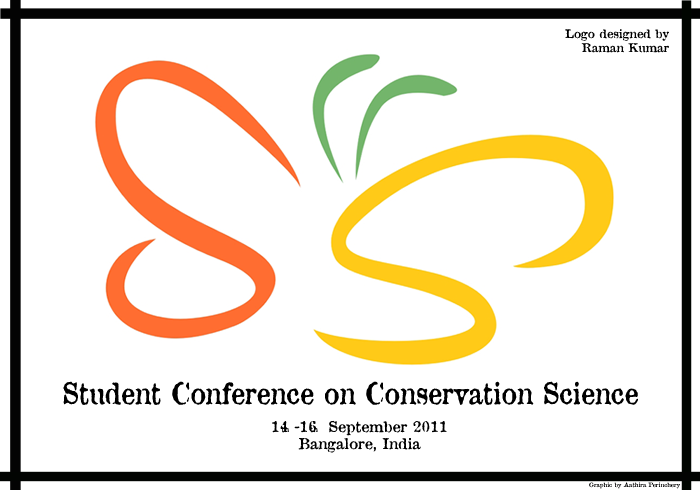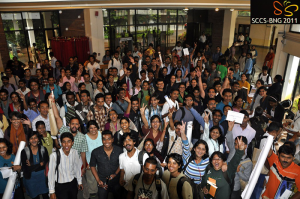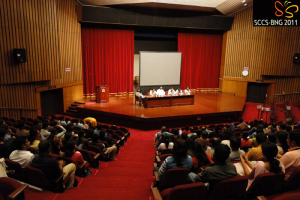The Student Conference on Conservation Science, Bangalore
"Just the workshop on Wikipedia editing," I told myself at the start of the conference. It would come in handy to start and edit NCBS wikipages, part of my work at the NCBS News team. "And maybe just the first plenary talk too". At the end of the three-day Student Conference on Conservation Science (SCCS), I realised I had attended almost every session: plenaries, student talks, workshops, poster rounds and discussions. What had made it so engaging?
At the J. N. Tata Auditorium in the Indian Institute of Science (IISc) campus in Bangalore, the first day of the conference was a flurry of activity: volunteers scrambling to and fro, tensed participants uploading their presentations, old friends exchanging news, new friendships being forged and the chatter of senior scientists and resource people as they exchanged greetings. The bonhomie was palpable: exciting to feel and amusing to watch.
The inaugural session on 14th September 2011 saw Raman Sukumar of the Centre for Ecological Sciences (IISc), D. Narasimha Rao, Dean of the Biological Division (IISc) and M.K. Mathew representing NCBS, extending words of welcome to the participants of SCCS. "We're proud to be associated with a conference for the students, of the students," said Mathew. "Make sure you're here, the principle rule in all conferences, to have fun," he added. That indeed I did.
The plenary talks were thought-provoking. "Is nature about numbers or relationships?", asked Rohan D'Souza (Jawaharlal University, New Delhi). Linearity is a necessary requisite for quantifying anything in terms of money, something nature and natural services hardly ever are. So can money ever be a surrogate for the quantification of nature? Professor at the University of Hong Kong, Yvonne Sadovy's talk was a shocking revelation (as most talks on marine conservation are) of the sad state of the over-harvested fish populations that cater to the luxury sea food market in the Orient. Andrew Balmford's talk was a revivifying breath of fresh air: a break from the view of nature's glass being half empty. "We make people painfully aware that there's a problem, but we give them no hope that there are solutions - that there is something we can do," the professor of conservation science at the University of Cambridge said, as he talked of his book in the making, 'Wild Hope'.
Particpants could register for a single 2-hour-workshop every day from a choice of five. Topics ranged from the 'Craft of Compelling Communication' (by NCBS scientific communication instructor Geoff Hyde) and the basics on how to edit topics on Wikipedia (taken by Wiki editors L. Shyamal and N.S. Prashanth); to the elements of good study design in ecology and conservation (instructed by Advait Edgaonkar of the Indian Institute of Forest Management and Kavita Isvaran from IISc) and the essentials of conservation genetics (taught by Uma Ramakrishnan from NCBS, Shomita Mukherjee from the Salim Ali Centre for Ornithology and Natural History, Vaibhav Chaturvedi and Subhankar Chakraborty from NCBS). "The workshops were extremely useful," says Mridul Kashelkar, a 2nd year masters' student in biodiversity at Garware College, Pune.
These workshops could only cater to a limited number of students. So on each day there was a parallel session, 'Beyond Science', for the substantial spillover of people. Discussion topics included conservation in the real world and the importance of activism. Renowned wildlife film-maker Shekar Dattatri screened 'Mindless Mining' and excerpts from a few of his other wildlife documentaries, followed by a discussion with the audience.
Such sessions camouflaged in new garbs and catchy titles were quite popular among the 200-odd participants of the conference. The 'Who's Who in Conservation' was a useful arena for project leaders and organizations in particular: a place to set up posters on their work and talk about it, at the same time attracting potential candidates to work with these projects. At the 'Birds-of-a-Feather' session anyone could start a discussion about a topic and interested participants could join in. Nearly twenty such sessions happened in tandem at different spots on the campus and topics included small mammal conservation, human-animal interactions, semi-arid ecosystems and the role of wildlife photography and films in conservation. "The 'Birds-of-a-feather' session was particularly useful. I really liked the concept where people with like-minded interests could come together," says Sayantan Das, a 5th year masters student at the Indian Institute of Science Education and Research, Kolkatta. His poster on the occupancy of sloth bears in Hospet in Karnataka won the third prize among fifty-four posters.
With an overarching theme, each talk session included four twelve-minute presentations by participants. The first session was about species in danger - and as Charudutt Mishra (Nature Conservation Foundation, Mysore) who chaired one of the sessions pointed out - the large, charismatic mammals we so frequently hear about didn't figure in the list. For a change, Asian small clawed otters in Cambodia, spoon-billed sandpipers in Bangladesh, gharials in central India, white-bellied shortwings in the Western Ghats and Sri Lankan magpies hogged the limelight across two days. The talks on habitats, disturbance, biodiversity, human communities and landscapes too were quite diverse: from Anushree Bhattacharjee's study in northern West Bengal confirming how translocating problem leopards brought human-wildlife conflict to an area that had none, to Lahiru Ishan Samaranayake's quantification of biodiversity in the traditional home gardens of Kandy in Sri Lanka. A total of 26 presentations were made across a span of three days. Cynthia Adeline Layusa's talk on distribution modelling for the Calayan rail in the Philippines and the effects of habitat loss on its conservation was adjudged the best.
Towards the end of each talk, the warning calls of raucous woodpeckers at the 10th minute and trumpeting elephants at the 12th minute were quite startling. And the host of cicada calls that drowned out the speaker's voice if the talk had not finished within 15 minutes did not go down too well with many participants though it served its purpose beautifully. But "Fantastic and wonderful", is how Sree Hari R. from the Kerala Agricultural University at Thrissur describes his experience at the conference. "I got a lot of suggestions for my work and it's been great for sharing ideas and information. We need this at least twice a year," he says. Something the organizers would not prefer visualizing immediately considering the four months of hard work that went into organizing the conference.
Many participants commented on what a well-run conference it had been when I discreetly ran around for quotes at the end. I particularly liked the thoughtful mug and water bottle that came with the participants' kit, as did a lot of others. "It was very well organised," says Nopphadon who came all the way from the Mahidol University in Bangkok to attend the conference. "The volunteers were very helpful too." A fair number of NCBS students were among the many who volunteered their services for the conference.
The dinners were a hugely social affair. Seeing participants interacting with new friends and not just hanging out with old company is always a welcome sight.
Resource people too seem to have found the atmosphere at the conference vibrant and enjoyable. "It was fantastically exciting," says Andrew Balmford. "There have been great presentations and talks. It's been a real thrill being here - the buzz, the energy of all people."
"It was very useful and fun, which is most important. The fact that people have come together to do this is great," says Asmita Kabra (Ambedkar University). "I liked the way all the sections of the conference added together."
Feedback from participants is vital for conferences such as these. The organizers are still in the process of collating the results but say they have received "very enthusiastic feedback, on everything from the conference program to food".
"Please put it on Facebook," says Shaina Sehgal from Ambedkar University (New Delhi), whose poster on the changes in the socio-economics of a village in Pin Valley National Park in Himachal Pradesh and their impacts on conservation initiatives was voted the best in the public choice category. "It was a good experience for me because I haven't studied ecology or conservation. There's no other common meeting ground otherwise. Now I know who's doing what research."
For Thilina De Silva, a zoology demonstrator from the University of Peradeniya in Sri Lanka, the bursaries for travel and accommodation helped him make it to the conference. "It's a really good opportunity especially for people from poor and developing countries. The bursaries were hugely useful. I've learnt so much and so many new methods", he says.
The SCCS conferences were initiated by the University of Cambridge (United Kingdom). The original SCCS conference in Cambridge has been running for 12 years now. The SCCS Bangalore and New York chapters were started in 2010 and plans are on for Beijing and Brisbane units as well. The SCCS-Bangalore conference was chiefly funded by the ADM Capital Foundation, Hong Kong. NCBS was one of the eight organizing institutions.
Well, I've learnt much from the conference too - and hope to put those newly-acquired skills of Wikipedia editing to good use for the NCBS wikipage. Do look out for revisions at http://en.wikipedia.org/wiki/The_National_Centre_for_Biological_Sciences in the not-too-distant future.



Comments
Post new comment